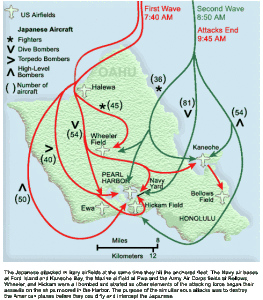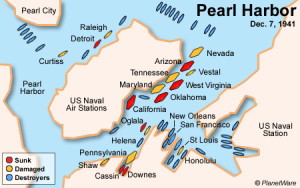Today marks the 74th anniversary of the Japanese Empire’s surprise attack on Pearl Harbor. One day later, President Roosevelt asked congress for a declaration of war against the Japan, which he received. In commemoration today’s post features two maps. The first courtesy of US History.com.
Flight path of the attacking Japanese aircraft
Two waves containing more than 350 aircraft launched from six carriers attacked US military installations on Oahu. The planes included fighters, bombers, and torpedo planes. The first wave hit at 7:48 am local time. The second just over an hour later at 8:50 am. The attacks ended at 9:45 am.
The second map (©PlanetWare) details the aftermath of the attack within Pearl Harbor.
All eight of the American battleships suffered hits. Four of them sank. All but the Arizona were raised and six returned to service in the war. Ten other ships including three cruisers and three destroyers were also damaged or sunk. Including the attacks on other island installations 188 aircraft were also destroyed. American casualties included 2,403 killed and 1,178 wounded. The Japanese lost 29 aircraft and five midget submarines with only 64 servicemen killed.
At roughly the same time as the Pearl Harbor attack the Japanese Empire attacked American positions in the Philippines, Guam, and Wake Island. They also attacked Malaya, Hong Kong, and Singapore in the British Empire.
As lopsided as those figures sound, the Japanese victory proved a strategic disaster. They did not destroy the American carriers. Additionally, their victories in the other theaters did not compel the US or the British Empire to bargain for peace. Less than four years later the Japanese Empire surrendered unconditionally to allied forces and ceased to exist.
Little known & interesting (at least to me on both counts) facts about Pearl Harbor
- Jeannette Rankin, the first woman elected to congress cast the sole vote against going to war. She also voted against declaring war with Germany in 1917. “As a woman, I can’t go to war and I refuse to send anyone else.”
- One Japanese sailor, Kazuo Sakamaki was captured in the attack. He was the sole survivor from the five two-man midget submarines. After the war he became a pacifist and rose to lead Toyota’s Brazilian division.
- The attack did not hit the submarine base or logistical facilities (fuel storage, repair facilities, etc.) making it easier for the US to recover.
- With the American carriers out of port, the Japanese cancelled a planned second set of attacks.
- During the government shutdown in 2013 servicemen and their families volunteered their time to tend to the attack memorial.
- In addition to the Arizona memorial, there’s a memorial for the Utah, the other battleship left on the bottom.
- The navy raised and salvaged the Oklahoma. On it’s way to California in 1947 to be scrapped it started to list and had to be cut free. It sank just over 500 miles from Hawaii.
- The Japanese surrendered on the deck of the Missouri, which is now docked within easy viewing of the Arizona memorial.
- Despite no obligation to do so (their treaty only covered attacks on Japan) on 11 December 1941 Germany declared war on the US. This gratuitous action brought the Americans into the European war.
- Fifteen men received the Congressional Medal of Honor for their heroic deeds at Pearl Harbor. Ten were posthumously awarded and one of the five survivors was killed in action eleven months later.
As an aside please consider signing up for my FREE author newsletter. It will contain opportunities to preview new books, announcements, and contests related to my novels. It will not overwhelm your inbox – I’m thinking once a month or less depending on news.
If you have subscribed, but haven’t received a newsletter, please check your spam folder. Moving the newsletter to your inbox should fix the issue.
As always thanks for reading.
Armen
PS Both the WW1 & WW2 votes cost Congresswoman Rankin her seat in the next election. Something she knew when she cast them. Whether you agree with her vote or not, you’ve got to admire her placing convictions above her re-election. Not something you’re likely to see now.



